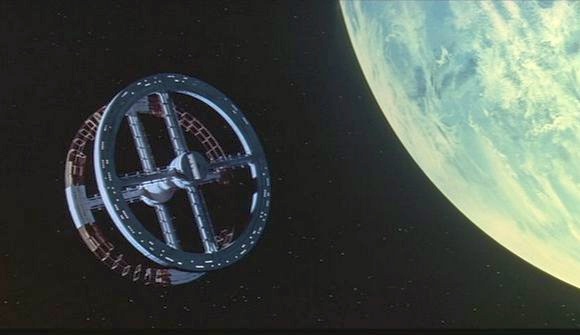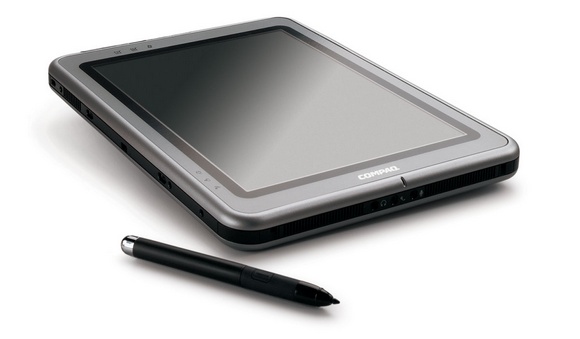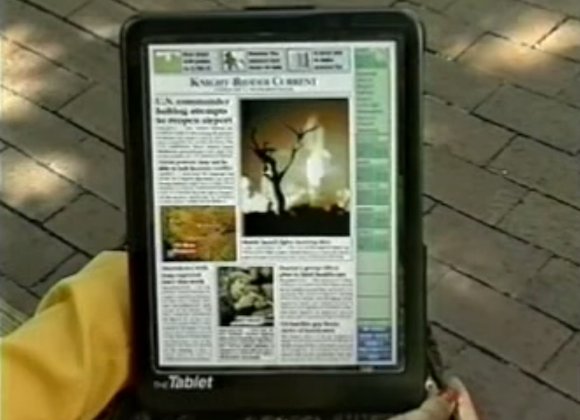Samsung Cites 2001: A Space Odyssey Against Apple in Greatest Legal Defense of All Time (Updated)
Apple is giving Samsung a legal pummeling because it thinks the latter stole the iPad’s design for the Galaxy Tab. So far, the fight’s going well for Apple . But Samsung has something up its sleeve : Apple ripped off science fiction.
Apple Demands Sales Ban Against Samsung in Growing Trade Battle
The slapping match between electronic giants (and major rivals) Apple and Samsung took another jump
Or so Samsung claims. Patent expert Florian Mueller noticed something odd in Samsung’s American legal counteroffensive : they argue the idea for the iPad existed back in 1968, when Stanley Kubrick dreamed up his sci fi classic. And in American patent law, if the idea existed before your patent application—what’s known as prior art—your patent is null. So essentially, Samsung is pulling a hell of a legal maneuver here, alleging they couldn’t possibly have stolen the iPad’s design, because Apple took it from an imaginary science fiction movie space station:
Attached hereto as Exhibit D is a true and correct copy of a still image taken from Stanley Kubrick’s 1968 film «2001: A Space Odyssey.» In a clip from that film lasting about one minute, two astronauts are eating and at the same time using personal tablet computers. The clip can be downloaded online at
. As with the design claimed by the D’889 Patent, the tablet disclosed in the clip has an overall rectangular shape with a dominant display screen, narrow borders, a predominately flat front surface, a flat back surface (which is evident because the tablets are lying flat on the table’s surface), and a thin form factor.
Mueller says it would be «amazing» if the court bought this. But Samsung does have a point, even if it’s a futile one. The problem with Apple’s radically minimal design is that it’s hard to say there’s terribly much singular about it. Unlike the design of, say, a Lamborghini, which is distinctive and iconic because of its detail, Apple’s gorgeous industrial design is striking because of how invisible it is.
All tablets are pretty much just black glass rectangles. Most smartphones are pretty much just smaller black glass rectangles. Apple certainly made this design ubiquitous through the iPad and iPhone, respectively, but did they invent it? With a form so vague, it might be hard to prove that they did. And if the realm of science fiction becomes fair game, the fights of Samsung—and any other company Apple might square off against—could become easier. I’d never have guessed Space Age design and beautiful futurism could be a liability. [ FOSS Patents via 9to5Mac ]
Learn everything forever
Improve yourself in the new year (and new years to come) with this unbelievable deal on a lifetime pass to classes. Includes everything from blockchain to Rosetta Stone.
Update: Turns out Daniel Kokin, whose «Video Pod» projector caught the ire of Apple legal for daring to use the word pod, employed the 2001 Defense way before Samsung. His argument? One (very memorable) line: «Open the pod bay doors, Hal.»
You can keep up with Sam Biddle, the author of this post, on Twitter , Facebook , or Google+ .
Источник
«Космическая одиссея: 2001» не помогла Samsung
На войне все средства хороши. Samsung пытается доказать свою правоту не только публикацией запрещённых доказательств, но и апеллируя к классике кино. А именно к легендарному фильму Стэнли Кубрика «Космическая одиссея:2001». В одном из его эпизодов на экране появляется прообраз нынешних планшетных компьютеров, который чем-то напоминает iPad. Неужто Apple украла идею отсюда?
На этом фрагменте чётко виден некий футуристический планшетник, на который поглядывают пилоты космического корабля во время обеда. Сам планшетник, кстати, брендирован частично почившей ныне IBM — однако на деле является статичной бутафорией, изображение на которую передавал установленный выше проектор. Но это уже лишние детали, ибо Samsung настаивает на другом: претензии Apple необоснованны, потому что отстаиваемые ими идеи уже были использованы ранее.
Судья Люси Кох ознакомилась с этим фрагментом, а также рассмотрела фото Compaq TC1000 и древний ролик Роджера Фидлера о тонком устройстве с цветным экраном, подозрительно похожем на iPad. Видео уже попадалось к нам на глаза.
Все три устройства ничем не помогут Samsung из-за того, что она слишком поздно объяснила, зачем включила эти изображения в процесс. По нынешним правилам, любая из сторон должна согласовывать такие «улики» заранее, чтобы противник успел подготовить контр-аргументы или хотя бы объясниться. Иными словами, мы имеем дело с маленьким техническим поражением корейцев. Кино не помогло. [ap]
Источник
Apple позаимствовала дизайн IPad у режиссера «Космической одиссеи 2001 года»
Среди прочих документов составляющих основу защитной стратегии, Samsung предоставила прокурору кадры из фильма Стенли Кубрика 1968 года.
В ходе судебного разбирательства между компаниями Apple и Samsung, последняя предоставила суду свою стратегию защиты. Среди представленных документов корейская компания представила прокурору кадры из фильма «Космическая одиссея 2001 года». Продемонстрированный момент из фильма 1968 года, показывает астронавтов, использующих для просмотра информации устройство внешне очень похожее на современные планшетные компьютеры.
Из документов Samsung следует: «Как и в случае с дизайном, описанном в патенте D504889, планшетный компьютер, показанный в этом клипе, обладает прямоугольной формой, занимающим основную площадь дисплеем, узкими краями, преимущественно плоской передней поверхностью, плоской задней поверхностью (что очевидно, поскольку планшетные компьютеры лежат, плотно прилегая к поверхности стола) и тонким формфактором».
Напомним, что в данном иске Apple требует от суда запретить продажи планшетного компьютера Galaxy Tab 10.1, поскольку он нарушает патент на дизайн. Однако стоит отметить, что Apple уже были уличены в фабрикации улик. В европейском суде обвинение предоставило суду изображение продукта конкурентов, растянутое таким образом, чтобы оно больше походило на IPad. Благодаря этой махинации им почти удалось запретить продажи Galaxy Tab в Европе.
Очевидно, что Samsung пытается доказать суду, что дизайн планшетных компьютеров был взят компанией Apple из упомянутого фильма. Тем не менее, многие специалисты утверждают, что на самом деле дизайн IPad был создан Apple на основе конкурса проведенного 23 года тому назад, среди студентов Иллинойсского университета. Сведения о конкурсе под названием «Каким будет персональный компьютер 2000 года?» содержатся в журнале «Наука и жизнь» за 1988 год.
Источник
How ‘2001: A Space Odyssey’ inspired Apple’s mobile device line-up
The Apple iPod, iPhone, and iPad are products that were far advanced at their time of introduction and revolutionized each of their respective market segments. Together, they epitomize state of the art consumer electronics and the current digital/communication age. So it might surprise some Apple fanatics that their beloved devices were inspired by an old movie filmed in 1965, before most of these purchasers were even born.
2001: A Space Odyssey (released in 1968 by MGM Studios) was a Sci-Fi movie set in the near future, showcasing predicted futuristic technologies. For a detailed analysis of the science of 2001, please refer to my earlier Memeburn article. Director/producer Stanley Kubrick worked side by side with science fiction novelist Arthur C. Clarke to depict spacecraft, personal electronic devices, and computer technology that would be so far advanced to be awe-inspiring on film, yet also feasible, practical, and most importantly believable. They also consulted with NASA engineers who were following President John F. Kennedy’s directive to put a man on the moon by the end of the decade (Neil Armstrong and Buzz Aldrin did so in 1969).
While the film was being conceived, NASA was spending the film’s total budget of US$10 000 000 every day, which meant NASA had almost unlimited resources and the brain trust to back it up. This showed the brilliance of Kubrick for tapping into this genius pool and also emphasizes the tremendous secondary benefits of investing in space exploration. Some of the most useful technologies produced in this era were never launched into outer space.
iPod (2001)
Just before this digital music device was released, Apple Inc. needed to come up with a marketable name. When freelance copywriter Vinnie Chieco saw the prototype at an Apple brainstorming session he immediately recalled the extravehicular activity Pod in 2001: A Space Odyssey. This EVA Pod (ePod) was the direct inspiration in naming the iPod. Although the form factor is clearly different, the functions are quite similar. Both are compact computer-driven devices, independently operating, supported by a much larger device (iMac or mothership), controlled by advanced human-interface hardware, and necessitated advance software (iTunes and artificial intelligence respectively).
Although relatively diminutive in size, the EVA Pod had several crucial roles in the movie: it facilitated repair of the exterior of the Discovery One mothership, it was the only place where the crew could speak in confidence “off the grid”, it killed the first astronaut under robotic computer control, it was the center of the most tense moment in the movie during the emergency hatch scene, and it was the vehicle that traversed the star-gate/wormhole. The diminutive iPod similarly had a huge role in the consumer electronics industry. The iPod revitalized Apple’s fortunes, forever altered the music industry, redirected the online buying habits of audiophiles, and single handedly eliminated brick and mortar music stores from the retail map. Both the ePod and iPod demonstrate that something small can be an instrument of tremendous change.

An astronaut in an EVA Pod attempts repair of the Discovery One antenna. Movie still, MGM.
iPhone (2007)
The source of this inspiration is less direct but is nonetheless uncanny in retrospect. The most mysterious and pivotal scenes in the movie are driven by the appearances of enigmatic monolithic structures. The outward appearance of the 2001 monolith is a vertical slab form factor, proportionally thin, and with a semi-reflective black surface. The original prop for the movie was a pyramid design which was scrapped in favor of a shape that is nearly identical to the current iPhone.
What makes it even more eerily similar to a telecommunications device is the interactive quality of the monolith. It was activated with human touch, it originally was intended to project video instructions on its surface (retained in Clarke’s book version), and its chief function was to send radio wave signals (as a cosmic alarm indicating that man had evolved enough to reach the Moon). This is the main plot of Clarke’s short story The Sentinel which was the literary seed of the movie’s larger concepts. Kubrick decided against the monolith looking like an instructional flat-screen television in favor of a more mysterious telepathic device.
The main argument against the monolith/iPhone connection was the large scale of the monolith. However, Kubrick is allowed some literary license because a small handheld device would not have had the same cinematic visual impact. Also in the Jupiter star-gate scene, the floating monolith has no reference scale and could be of any size. The handheld nature of the iPhone also has ties to the first act of the movie in which the synergistic evolution of the brain with the opposable thumb enabled early humanoids to invent the first manual tool. This break away from a tenuous subsistence existence was a critical stage in our evolution. The final “hotel room” scenes also featured an outstretched finger reaching towards a monolith, ushering the next stage of human evolution…this time beyond the infinite.
Another advanced theme of the movie was artificial intelligence (AI). Siri (Speech Interpretation and Recognition Interface, 2001) is employed in iOS devices and mimics the self-aware artificial intelligence depicted in the movie by the Hal 9000 (Heuristically-programmed ALgorithmic computer). One controversial measure of successful AI is the Turing Test first suggested in 1950: a human-to-computer conversation should be indistinguishable from human-to-human interaction, which was the goal of both Siri and Hal.

Ancestors of early man in Africa receive telepathic instruction from Kubrick’s monolith. Movie still, MGM.
iPad (2010)
In a Jupiter mission scene aboard Discover One, the astronaut actors casually eat while watching downloaded prerecorded video on tablet computers. One criticism of the movie was the mundane level of action. However, Kubrick correctly envisioned sophisticated technology as being seamlessly incorporated into day-to-day activities, just as Steve Jobs foresaw. These tablet devices had a thin rectangular shape, flat front and rear surfaces, narrow borders, image dominant screens, and the size of current iPads. Be aware that in 1965, computer generated imagery (CGI) was not available, so it is likely that conventional tube TVs were installed inside the table with a false border overhanging the table edge to look like mobile flat-panel devices.
In the book version, Clarke described the fictional tablet as a “NewsPad” with wireless digital updating and touch-expandable screen icons, further predicting the name and functionality of the iPad. Due to limitations in 1960’s film technology, mobile prototypes did not exist, so Kubrick had to resort to pen & paper clipboards in the scenes where the crew performed preventative maintenance checks, but you can imagine a stylus & digital tablet fulfilling this role.
In another scene, the Hal 9000 computer recognises hand-drawn ink on paper sketches as portraits of an individual hibernating crew member, which signified Hal’s advanced AI in the facial recognition of analog artwork. Perhaps Kubrick had cinematic reasons for including paper in some scenes. For Hal to interact with humans, he needed more than just digital capabilities. He also needed to work at the analog level.

Actors Gary Lockwood and Keir Dullea eat a meal in space while they watch a recorded video interview on personal tablet computers, nearly identical to the iPad. Movie still, MGM.
For years the Apple and Samsung corporations have been involved in titanic legal battles regarding the proprietary inventions and patents of mobile phones and tablet computers. In geeky sci-fi Star Wars terms, it has been equivalent to the battles between the light and dark sides of the Force (I will leave it to you to decide which sides are good and evil).
“We have little choice but to take the steps necessary to protect our innovations and intellectual property rights.”
– Samsung
“I’m going to destroy Android…I’m willing to go thermonuclear war on this.”
– Steve Jobs
The scene shown in the movie still above was actually submitted as evidence by Samsung that Apple did not invent the iPad. Samsung utilised the “prior art” defense, claiming that Kubrick had already invented the tablet computer in the 1960s. Recently, the two sides have apparently cooled and have decided to not contest their patent lawsuits outside of the US. However, expect the US suits to intensify because of the huge sums of money involved.
What should be clear to judges of these cases is that it is best to have multiple players in the electronics industry for reasons of technologic evolution through competition, accelerated creation of new and more refined products, and for consumer choice. With this perspective, technology is analogous to George Lucas’ ubiquitous and ambivalent Force. Both Apple and Samsung should be allowed to coexist on their respective sides for the benefit of the consumer.
Movie stills are credited to 2001: A Space Odyssey, 1968, Metro Goldwyn Mayer (MGM Studios).
Источник








